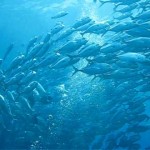 There are a growing number of games that allow citizen scientists to participate in science in some way. Most of these games use the players to perform a kind of quality control process.
There are a growing number of games that allow citizen scientists to participate in science in some way. Most of these games use the players to perform a kind of quality control process.
For instance, Eyewire is a game that aims to improve our understanding of neuroscience. Phylo is a logic game that aims to bolster our knowledge of genetics. EteRNA is a game that explores the folding patterns of RNA, whilst NOVA is tackling a similar issue, but with the hope that it will get youngsters involved.
A recent project by the Department of Mathematics at Uppsala University has seen a new game developed to allow players to help test the models created to mimic the movement of a shoal of fish.
Using the crowd to test mathematical models
The researchers were hoping to understand how complex systems function, which in this case was the shoal of fish. They developed a number of models to try and test their thesis, and then developed a Turing test style game to get lay people putting the models through their paces.
Over 1,700 people played the game, in which they were tasked with distinguishing between the actual movements of the fish and the simulations proposed by the model.
“By putting the game online, and though crowd sourcing this problem, the public have not only become engaged in science, they have also helped our research,” the team say.
Alas, it isn’t immediately clear that the game will have long-term benefits as the amateur players proved no more effective at spotting the difference than experts.
It did nonetheless provide insight into how successful amateurs went about their analysis, which suggests that the approach has plenty of room for improvement.
“These players commonly suggested that the spatial organization of the groups and smoothness of the trajectories appeared different between the simulated and real schools. These are aspects of the model we can try to improve in the future”, the researchers say.
“Our results highlight that we can use ourselves as Mechanical Turks through ‘citizen science’ to improve and refine model fitting,” they conclude.